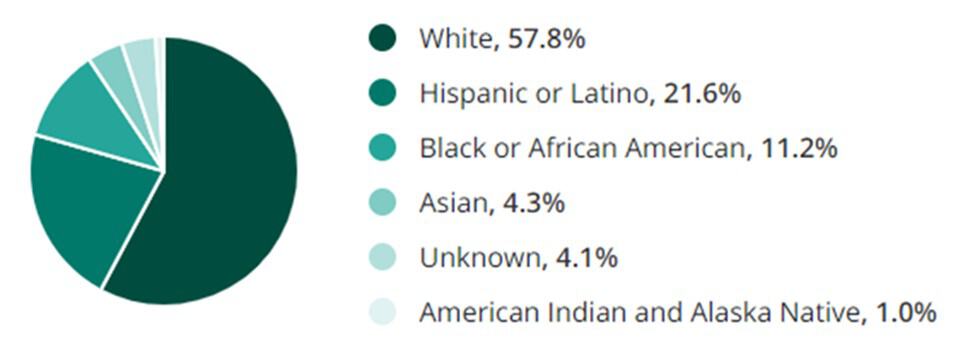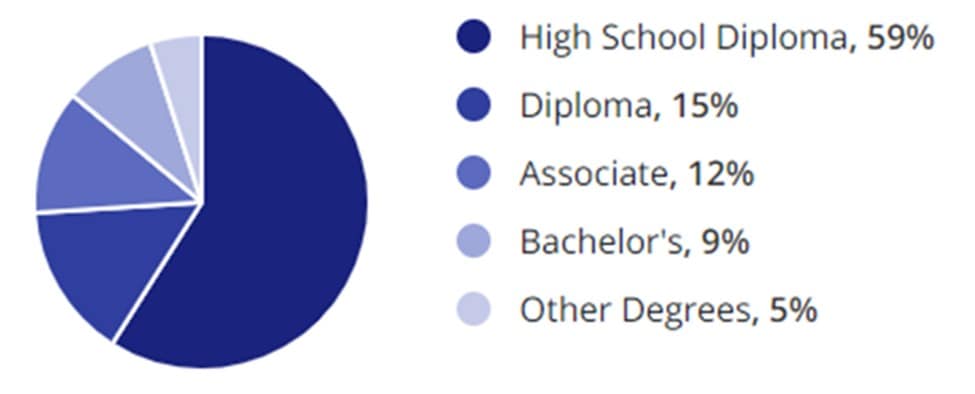Welcome to the ultimate guide for pursuing a career in skilled labor. You’ve come to the right place if you’re drawn to hands-on work and possess a keen interest in mastering a trade. Skilled labor jobs are foundational to our economy, driving our physical world’s construction, maintenance, and operation. From constructing skyscrapers to ensuring our homes are safely wired, skilled laborers play a critical role in shaping our daily lives.
This guide is designed to explore the fascinating opportunities within skilled labor jobs. Whether you’re considering a career shift, acquiring new skills, or simply exploring what the field offers, we provide comprehensive information on education requirements, areas of expertise, current job market trends, and much more.
Starting a skilled labor career is not only about securing a job; it’s about joining a community of dedicated professionals who take pride in their crafts. It’s about contributing to projects that last generations and make tangible impacts on our communities. With the proper preparation and resources, a career in skilled labor can be both fulfilling and lucrative.
Read on to discover how to unlock your potential in the skilled labor market and build a thriving career in a sector that values hard work, expertise, and diversity. Join us as we dive into what it takes to succeed in skilled labor jobs, the backbone of our society’s infrastructure and growth.
Educational Requirements
Entering skilled labor jobs opens opportunities for those with a hands-on approach to work. The educational path to becoming a skilled laborer is as diverse as the field. The foundation often starts right after high school, whether you’re eyeing a position outlined in a skilled laborer job description or seeking semi-skilled labor jobs.
Many positions require only a high school diploma coupled with thorough on-the-job training. This practical approach allows newcomers to gain direct experience while earning an income. Vocational training or attending a trade school can be essential for specific trades. These programs typically last a few months to two years, offering specialized instruction and hands-on experience in electrical work, plumbing, or carpentry.
Apprenticeships are another gateway into skilled labor careers, merging classroom instruction with real-world training under the guidance of experienced professionals. Lasting anywhere from one to six years, apprenticeships are invaluable for those aspiring to roles that demand in-depth knowledge and expertise.
In some trades, certifications are a testament to your skill level and commitment to maintaining a high standard of work. Obtaining certification might require passing exams or completing specific training programs. For job seekers, certifications could significantly bolster your resume.
While some skilled labor jobs might not require formal education beyond high school, advancing in the field often entails specialized training or certifications. This blend of education and hands-on learning equips you with the necessary skills and enhances your marketability in the job market.
Areas of Expertise
Skilled Labor Jobs encompass a broad spectrum of professions requiring unique skills and expertise. Here are some of the primary areas of specialization within the skilled labor market:
- Construction and Carpentry: This area involves building structures from the ground up or renovating existing ones. Skilled workers in this field might focus on residential homes, commercial buildings, or infrastructure projects. Learn more about construction careers with our Ultimate Guide to Construction Jobs.
- Electrical and Plumbing: Electricians and plumbers are essential to any construction or renovation project, ensuring that homes and buildings are safe, functional, and compliant with regulations.
- HVAC (Heating, Ventilation, and Air Conditioning): Specialists in this sector focus on the systems that keep environments comfortable and air quality high. This specialization is crucial for new installations and maintenance of existing systems.
- Welding and Metal Fabrication: These skilled laborers work with metal to create components for various structures and products. Their expertise is critical in industries ranging from automotive to construction.
- Automotive and Machinery Repair: Proficiency in repairing vehicles and heavy machinery is a sought-after skill, with expertise spanning routine maintenance to more complex repairs and overhauls. Explore more on the automotive industry in our Ultimate Guide to Automotive Jobs.
Regardless of the specialization, a dedicated skilled laborer’s job description typically focuses on safety, precision, and problem-solving. The demand for skilled labor in construction, electrical work, and automotive repair is consistently high, providing ample opportunities for those looking to enter or advance in these sectors. As technology evolves, staying updated with the latest methods and tools becomes integral to excellence in any skilled labor profession.
Demographics in the United States
Ethnicity/Race:
The landscape of skilled labor jobs in the United States is marked by its diversity, mirroring the mosaic of the nation’s population. The ethnic and racial composition of this sector is less diverse, consisting of:
- White: 57.8%
- Hispanic or Latino: 21.6%
- Black or African American: 11.2%
- Asian: 4.3%
- Unknown: 4.1%
- Native American and Alaska Native: 1%

Gender:
While historically skewed, the gender distribution in skilled labor jobs is evolving. Currently, the breakdown is as follows:
- Male: 86.2%
- Female: 13.8%
Though the sector remains predominantly male-dominated, efforts are underway to encourage and support more women in pursuing careers in skilled trades, aiming to create a more balanced and inclusive workforce.

Age:
The age demographics within the skilled labor market are wide-ranging, reflecting the sector’s appeal across generations. The average age of professionals in this field is over 40 years old. This variation in age brings together the vigor and adaptability of young workers with the wisdom and experience of older professionals, fostering an environment rich in mentorship and continuous learning.
Understanding these demographics is crucial for employers building diverse and dynamic teams. It also underscores the importance of inclusivity and equality in growth opportunities within the skilled labor sector, ensuring that the workforce truly reflects the diversity of the society it serves.

Salary Trends
Compensation in skilled labor jobs varies widely, influenced by specific trade, geographical location, and individual experience. On average, entry-level positions in the skilled labor sector might see salaries starting around $35,000 annually. However, for seasoned professionals or those in specialized trades, earnings can exceed $80,000 per year.
Salaries also reflect the demand for specific skills in the marketplace. For instance, skilled laborers in metropolitan areas or high-demand sectors may command higher wages. The following trends are noteworthy:
- Construction and Carpentry: Due to ongoing development projects, professionals in these areas can expect competitive compensation, particularly in urban settings.
- Electrical and Plumbing: Given the specialized training required and the critical nature of these professions, electricians and plumbers often enjoy higher wage brackets.
- Automotive and Machinery Repair: As technology in vehicles and machinery advances, skilled technicians with updated knowledge can leverage their expertise for improved pay.
In addition to base salary, many skilled labor positions come with bonus opportunities, overtime pay, and benefits such as health insurance, retirement plans, and paid leave. For job seekers, it’s pivotal to consider the total compensation package when evaluating job offers.
As the economy evolves and new technologies emerge, the value of skilled labor continues to be acknowledged through steady salary increases. This trend highlights the importance of continuous learning and certification in advancing one’s earning potential in the skilled labor jobs market.
Hiring Trends
The demand for skilled labor remains robust, driven by continuous construction, maintenance, and technical services needs. Current employment trends suggest a positive outlook for those seeking opportunities in skilled trades, with certain factors influencing job availability and growth:
- Infrastructure Development: Government and private sector investments in infrastructure projects boost demand for skilled construction workers, electricians, and plumbers.
- Technological Advancements: Technology integration across industries has created a need for skilled laborers proficient with digital tools and automation technologies.
- Renewable Energy Projects: The push towards sustainable and green energy solutions has increased the need for specialized skilled labor in areas such as solar panel installation and wind turbine maintenance.
- Retirement of Aging Workers: As a significant portion of the skilled labor workforce approaches retirement age, opportunities arise for new workers to fill these roles, especially in trades experiencing skills shortages.
While the overall outlook is positive, aspiring skilled laborers should stay informed about the industry trends specific to their area of interest. For instance, those eyeing skilled laborer jobs should note the growing emphasis on green building practices in construction, which might require additional certifications or training.
The evolving nature of skilled trades means continuous learning and adaptability are crucial for career longevity. Prospective job seekers should not only focus on traditional skills but also emerging technologies and practices within their fields. With an estimated growth of 5% over the next few years, the skilled labor market is poised to offer numerous opportunities for qualified candidates.
Education Levels
The landscape of skilled labor is nuanced, with various roles that demand different levels of education and training. From positions that require the hands-on experience gained through apprenticeships to roles necessitating advanced certifications, the education level among skilled laborers can vary significantly:
- High School Diploma or Equivalent: Many skilled labor jobs, especially entry-level positions, require a high school diploma or GED. Initial training often takes place on the job, providing the essential skills to begin a trade career.
- Vocational Training: Vocational schools and community colleges offer programs tailored to specific trades, such as welding jobs, HVAC jobs, and automotive repair. These programs typically last a few months to two years and mix classroom learning with practical experience.
- Apprenticeships: Combining on-the-job training with classroom instruction, apprenticeships are a pathway to careers in skilled trades like welder, electrician, plumber, and carpenter. Apprenticeships can last up to six years, depending on the trade and complexity of skills required.
- Certifications: Certain skilled labor roles may require professional certifications that validate expertise in a specific area. These certifications often require passing exams and may need to be renewed periodically through continuing education.
Education and training are closely linked to career progression and earning potential in the skilled labor job market. Whether starting with a high school diploma or pursuing specialized training, there are many opportunities for growth and advancement. The key is continually seeking knowledge and certifications relevant to one’s trade and staying adept in an ever-evolving field.

Skills in Demand
The skill set required in skilled labor jobs is vigorous, reflecting both the timeless crafts of the trades and the modern demands of technology. As the industry evolves, so do the skills that employers prize most. Here are some of the critical capabilities sought after in today’s skilled labor market:
- Technical Proficiency: Mastery of core trade skills—be it in carpentry, electrical work, plumbing, or another specialty—is fundamental. Employers look for workers who can demonstrate deep knowledge and competence in their craft.
- Safety Awareness: A keen understanding of and adherence to safety protocols and practices is critical. Given the hands-on nature of skilled labor jobs, they prioritize safety benefits for the individual and their coworkers. Safety first.
- Problem-solving Skills: The ability to troubleshoot on the spot and devise practical solutions is invaluable, especially when unexpected issues arise on the job site.
- Technological Agility: With many trades incorporating digital tools and platforms, proficiency in relevant technology is increasingly important. This might include software for design, project management, or equipment operation.
- Soft Skills: Communication, teamwork, and customer service are essential in ensuring successful projects and satisfied clients. Effective collaboration with colleagues, contractors, and clients is critical to many skilled labor roles.
For job seekers, aligning their skill set with these demands is crucial. Whether taking additional courses, obtaining certifications, or gaining experience through apprenticeships, enhancing these skills can significantly improve employability and career prospects. As the demand for skilled labor continues to grow, those who invest in their capabilities will be well-positioned for success in this rewarding field.
Current & Future Skilled Labor Jobs Outlook
The outlook for Skilled Labor Jobs is promising, highlighted by sustained demand across various sectors. Ongoing infrastructural developments, technological advancements, and a growing emphasis on sustainable practices drive this demand. Here’s a closer look at the current and future trends shaping the skilled labor market:
- Steady Demand: Critical sectors such as construction, automotive repair, and HVAC continue to experience a constant need for skilled laborers. This is fueled by new projects and the necessity of maintaining existing infrastructure.
- Technological Integration: As industries embrace new technologies, the demand for skilled laborers who can operate advanced machinery and utilize digital platforms is rising. Adaptability to technological changes is critical to career longevity in skilled trades.
- Renewable Energy Projects: The shift towards renewable energy sources opens new avenues for skilled labor. Jobs in solar panel installation, wind turbine maintenance, and other green technologies are expected to grow significantly.
- Skills Gap: Retaining a significant portion of the existing skilled workforce creates opportunities for new entrants. However, a notable skills gap needs to be addressed through education and training programs.
The future of skilled labor jobs is not just about filling positions but also about adapting to the changing work landscape. Continuous learning and skill development are essential for those in the field to capitalize on emerging opportunities. With the projected growth and evolving nature of skilled trades, now is an exciting time for existing professionals and those considering a career in this vital sector.
FAQ’s
What qualifications do I need to start a skilled labor career?
Qualifications vary by trade but typically include a high school diploma or equivalent, with many positions requiring additional vocational training, apprenticeships, or certifications specific to the trade.
How long does it take to complete an apprenticeship?
Apprenticeships can last from one to six years, depending on the trade and complexity of skills required. They combine on-the-job training with classroom instruction, offering a comprehensive path to mastery.
Are there opportunities for advancement in skilled labor careers?
Absolutely. Skilled labor careers offer various paths for advancement, from becoming a senior technician or craftsman to moving into supervisory or management roles. Continuous learning and obtaining advanced certifications can accelerate career growth.
Is it possible to transition between different skilled labor trades?
While some skills are transferable, transitioning between trades often requires additional training or certifications specific to the new field of interest. However, the foundational experience gained in one trade can provide a valuable perspective in another.
How does technology impact skilled labor jobs?
Technology is increasingly integrated into skilled labor, with digital tools and automation enhancing efficiency in many trades. Staying adept with technological advancements relevant to your trade is crucial for maintaining competitiveness in the job market.
Where can I find skilled labor job opportunities?
Skilled labor job opportunities can be found on job boards, through trade unions, at vocational schools, and on platforms dedicated to skilled trades. Networking with professionals in your field can also uncover opportunities.
Additional Resources
Starting or advancing a career in skilled labor jobs is an exciting journey, offering many opportunities for personal and professional growth. To support your trip, here are some additional resources that can provide valuable information, training opportunities, and industry insights:
- The Bureau of Labor Statistics offers comprehensive data on employment statistics, wage estimates, and occupational outlooks across various trades.
- The Occupational Safety and Health Administration (OSHA) provides resources on workplace safety standards and training programs to ensure you’re equipped to maintain a safe work environment.
- The National Center for Construction Education and Research (NCCER) is a recognized leader in providing the construction industry’s standardized training and certification programs.
- CareerOneStop, sponsored by the U.S. Department of Labor, is an excellent tool for job searching, career exploration, and training programs.
- The National Institute for Automotive Service Excellence (ASE) offers certifications for automotive professionals, enhancing your credibility and proficiency in the field.
These resources can be valuable in helping you walk the tightrope of skilled labor professions. Whether you’re just starting or looking to advance your career, using these resources can pave the way for success in skilled labor jobs.
Conclusion
Skilled labor jobs offer a varied and rewarding career path filled with opportunities for growth, innovation, and personal satisfaction. With the proper training and skills, individuals can pursue fulfilling careers across various industries. As the demand for skilled laborers rises, now is an excellent time to explore or advance within this sector.
For those aspiring to embark on or further their careers in skilled labor, joining Diversity Employment is an empowering step. Our platform connects job seekers with diverse opportunities and supports the mission of endorsing inclusivity within the workplace. We invite you to create an account, upload your resume, and join our thriving community. Let’s work together towards building a more inclusive and skilled labor force.




